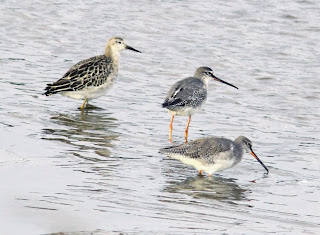Another cloudy, windy, showery, north-westerly morning with no chance of a ringing session led me to Conder Green where there is always a good selection of birds with not too many Sunday Morning grockles for the first hour or two. The alternative was a bout of bush bashing in search of little brown or green jobs, if I could find a sheltered warm spot on our eternally windy coast. I suppose that is the only downside of living so close to the sea, the isobars not only pack a bit closer, they often pack a punch on even the most innocuous looking morning.
It was the normal situation at CG, it seemed quiet with not a lot of birds immediately apparent, but I gave it time for the birds to show and a while for me to find them. The 7 Little Grebes were a bit more obliging this morning near the closest island with no need for me to go to the far end of the pool where they usually hang out, disinclined to venture very far. The 3 Wigeon were also reasonably close initially, but drifted off once they realised cameras and ‘scopes were about again; half a dozen Teal in the shallows also sloped off to a safer distance, but I had my doubts about how wild were the 4 Mallards.



I made the observation once before, but maybe it’s worth repeating. To wildfowl, and probably to waders with whom they frequently mix, a human pointing a telescope must look remarkably like one wielding a shotgun, a scenario which they remember and to which their instincts are attuned for an immediate response. Therefore we shouldn’t be surprised when at the first sight of the human form or noises associated with us, such birds flee from our presence. All the more reason then if we wish to observe and photograph birds is for us to learn and adopt fieldcraft, something so obviously lacking in many of the newer untutored birders who arrive hot foot from pager messages with expensive top of the range equipment but without an apprenticeship or the essential skills to acquire the best from their recent purchases.
Also on the pool, 1 Little Egret, 15 Lapwing, a Grey Heron and the Kingfisher doing a circuit of the pool before it disappeared to the furthest bank and out of sight. From the platform I watched a Wheatear that took a liking to the posts that mark the road during high tides, as it perched up on several of them in turn as passing cars made it favour one after the other. It’s not a bird I’ve ever seen much of just here, and they are much more likely to appear just up the road at Glasson.
In the creeks I counted 4 Greenshank, 3 Spotted Redshank, 6 Snipe, 2 Common Sandpiper, 7 Curlew, 18 Redshank, 1 Curlew Sandpiper, another Little Egret, 26 Teal and unusually, a Ringed Plover. I took some distance shots at ISO 800 in the poor light, but what a fine selection of waders all at close quarters and I asked myself why would anyone go elsewhere to see such birds?


From the roadside I could see lots of Goldfinch in the hawthorns near the bridge so I drove round and checked them out. There was actually a flock of 120 birds flying between the marsh and the hedgerows near the viaduct, spooked a couple of times that I could see, by on the second occasion an overflying Sparrowhawk that obviously took a close interest in such a plentiful, easily caught supply of food.
I drove up to John’s set aside for a check on the finches using the plot. If it wasn’t so close to the road and passing traffic I am sure the numbers would increase from the 40 Greenfinch, 8 Chaffinch and 4 Linnet I saw today, but for now I am hoping there is a bit of a settled spell that builds up the flock followed by a windless, mist net suitable day.






















































.jpg)












